american shad
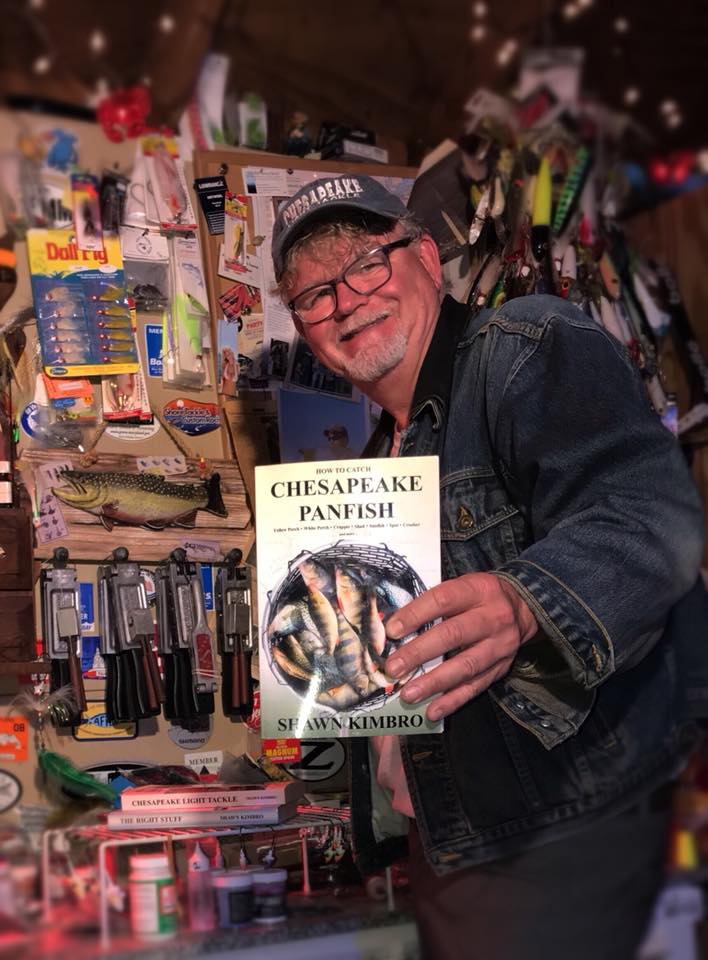 UPDATE 10/7/2018: Books have arrived and we are now shipping!
UPDATE 10/7/2018: Books have arrived and we are now shipping!
Good news! My new book is now available for pre-order. You can select either a limited edition hard cover or a first edition soft cover by clicking on the book pictures on the right side of this page. We expect books to arrive anytime and we will begin shipping as soon as we get them. All pre-ordered books are guaranteed to arrive before the official release date of October 15, 2018. After October 15, books will also be available in tackle shops in both Maryland and Virginia, at Amazon.com, and at other online outlets such as JigTheBay.com. Both the hard cover and soft cover contains 340 pages of which 43 are printed in color. There are over 100 photos and illustrations. Soft covers are $24.95 + shipping and hard covers are $39.95.
From the back cover:
Whether you fish from a boat, kayak, or the bank, there is nothing more fun than catching panfish in the Chesapeake Bay. Digging deep into his bag of panfishing tricks, lifelong angler Shawn Kimbro lays out the best year-round strategies for catching perch, crappie, bluegill, shad, and other species in the tidal waters of the Chesapeake Bay. Featuring the locations of prime fishing spots in Maryland and Virginia along with the history of some of the region’s most popular lures, you’ll find details about the best baits, rigs, lines, rods, reels, and other tackle. Enhanced with entertaining fish tales and illustrated by Eva Nichols’ artful sketches, this book is perfect for both beginning anglers and seasoned panfish pros.
I’m super excited about this new release and very happy to have the opportunity to share my knowledge and research with you my friends and fellow anglers. I hope you enjoy reading it as much as I loved writing it. I look forward to seeing you on the creeks and rivers this fall and winter!
–Shawn
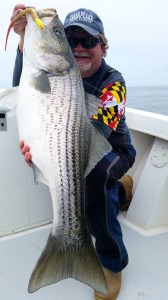 If fishing can be a feast or famine activity, anglers in the Chesapeake Bay region have been eating high on the hog lately. As is typical with April, all good things happen at once. In the past two weeks, I’ve caught shad, white perch, yellow perch, bass, bluegill, crappie, catfish, and stripers. Throw in the walleye and snakeheads my friends are catching, and we’re smack in the middle of a virtual smorgasbord of good fishing. The weather has been spotty, but that hasn’t kept too many anglers off the water. Here’s my report:
If fishing can be a feast or famine activity, anglers in the Chesapeake Bay region have been eating high on the hog lately. As is typical with April, all good things happen at once. In the past two weeks, I’ve caught shad, white perch, yellow perch, bass, bluegill, crappie, catfish, and stripers. Throw in the walleye and snakeheads my friends are catching, and we’re smack in the middle of a virtual smorgasbord of good fishing. The weather has been spotty, but that hasn’t kept too many anglers off the water. Here’s my report:
Yellow Perch: It’s all but over now, but we enjoyed one of the best March ring-perch runs in recent memory. Neds ran big this year and they were plentiful. They were also a little earlier than usual. That made it nice for those of us who were just about going crazy with cabin fever. Most of my fishing was in the Eastern Shore creeks and rivers. I fished Tuckahoe Creek and the Choptank River from Denton up to Red Bridges park. Some days it was one fish after another and on other days it was slow. Yellow perch can be finicky at times. When they are spawning they typically move up the streams in waves. If you aren’t catching, stick around because chances are another wave will move through and you’ll start getting bites again. See my earlier post for more information about the yellow perch run.
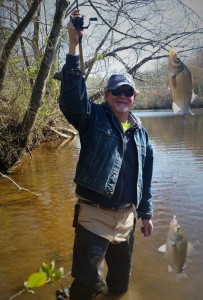 White Perch: I thought the white perch spawn might be over until I got a call from my friend Phil Kerchner last week. He was still lighting up the black backs in the creeks near his place at Wye Mills. I called him last Sunday and we met on the banks of Tuckahoe Creek. It was one pre-spawn white perch after another for a little while. Our best lures were Bust ‘Em Baits stingers and small twister tails rigged in tandem on one-sixteenth-ounce jig heads. As the tide changed, the bite slowed down, but it picked back up before sunset and we took home a very nice stringer. White perch are my favorite fish to eat. I even prefer them over crappie and I think they’re way better than yellow perch. All things in moderation of course, but don’t feel bad about keeping what you want to eat because white perch aren’t threatened and they reproduce prolifically. They will generally hang around the spawning grounds for a little while after they spawn, so I wouldn’t be surprised if we keep catching them in the creeks for a couple of more weeks. After that, they’ll spread out along the shorelines where they can be targeted all summer long.
White Perch: I thought the white perch spawn might be over until I got a call from my friend Phil Kerchner last week. He was still lighting up the black backs in the creeks near his place at Wye Mills. I called him last Sunday and we met on the banks of Tuckahoe Creek. It was one pre-spawn white perch after another for a little while. Our best lures were Bust ‘Em Baits stingers and small twister tails rigged in tandem on one-sixteenth-ounce jig heads. As the tide changed, the bite slowed down, but it picked back up before sunset and we took home a very nice stringer. White perch are my favorite fish to eat. I even prefer them over crappie and I think they’re way better than yellow perch. All things in moderation of course, but don’t feel bad about keeping what you want to eat because white perch aren’t threatened and they reproduce prolifically. They will generally hang around the spawning grounds for a little while after they spawn, so I wouldn’t be surprised if we keep catching them in the creeks for a couple of more weeks. After that, they’ll spread out along the shorelines where they can be targeted all summer long.
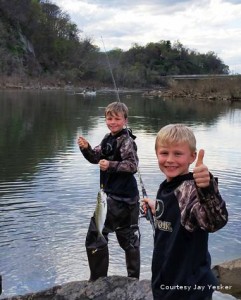 Shad: The shad run is in full swing. I’ve fished the Potomac around Fletcher’s Cove and Chain Bridge twice now and found shad in good numbers both times. Joe Yack is reporting shad in the Susquehanna now as well. The good news is that hickory shad are running big this year. I’ve seen at least two reports of hicks approaching five pounds. Some anglers mistakenly identify bigger hickory shad as white (American) shad because, when they are fully mature, they lose the spots on their shoulders. The key to identifying shad is to look at the lower jaw. If the lower jaw projects beyond the upper one with the mouth closed, it’s a hickory. I typically cast one-quarter or one-eighth ounce shad darts. It pays to experiment when you’re shad fishing because the same colors and techniques that work one day might not work the next. Last week, my fishing buddy Jay Yesker out-fished me by snap-jigging two quarter-ounce darts on eight-pound-test monofilament. (That’s Jay’s boys in the picture.) The fish were taking on the fall. Since my usual spinning rig is eight-pound-test braid with a similar size fluorocarbon leader, I couldn’t duplicate what he was doing because the force of the snap using the stretchless braid would break my leader. You can bet I was rigged with mono the next time I went out, but wouldn’t you know it, on that day the fish wanted a steady fast retrieve! You just don’t know until you go. The shad run should last for several more weeks, so there’s still plenty of time to get in on the action. Read More!
Shad: The shad run is in full swing. I’ve fished the Potomac around Fletcher’s Cove and Chain Bridge twice now and found shad in good numbers both times. Joe Yack is reporting shad in the Susquehanna now as well. The good news is that hickory shad are running big this year. I’ve seen at least two reports of hicks approaching five pounds. Some anglers mistakenly identify bigger hickory shad as white (American) shad because, when they are fully mature, they lose the spots on their shoulders. The key to identifying shad is to look at the lower jaw. If the lower jaw projects beyond the upper one with the mouth closed, it’s a hickory. I typically cast one-quarter or one-eighth ounce shad darts. It pays to experiment when you’re shad fishing because the same colors and techniques that work one day might not work the next. Last week, my fishing buddy Jay Yesker out-fished me by snap-jigging two quarter-ounce darts on eight-pound-test monofilament. (That’s Jay’s boys in the picture.) The fish were taking on the fall. Since my usual spinning rig is eight-pound-test braid with a similar size fluorocarbon leader, I couldn’t duplicate what he was doing because the force of the snap using the stretchless braid would break my leader. You can bet I was rigged with mono the next time I went out, but wouldn’t you know it, on that day the fish wanted a steady fast retrieve! You just don’t know until you go. The shad run should last for several more weeks, so there’s still plenty of time to get in on the action. Read More!
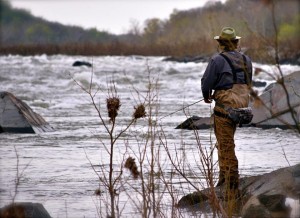 April showers bring cherry blossoms and tourists to the Mid-Atlantic. Since cherry trees were first planted around the Tidal Basin in 1912, people from all over the world travel to Washington D.C. to welcome the arrival of spring. This is also the time when fishermen look forward to other visitors making their way up the Potomac. In late March, the hickory shad run begins bringing some of the most exciting fishing of the year.
April showers bring cherry blossoms and tourists to the Mid-Atlantic. Since cherry trees were first planted around the Tidal Basin in 1912, people from all over the world travel to Washington D.C. to welcome the arrival of spring. This is also the time when fishermen look forward to other visitors making their way up the Potomac. In late March, the hickory shad run begins bringing some of the most exciting fishing of the year.
Hickory and white shad are anadromous species that spend the vast majority of their lives at sea, but enter the Chesapeake region in the spring. They swim through the Bay and up the rivers looking for the fast water they need in order to spawn. Shad hold an important place in American history. The Native Americans fished for them extensively and used them to fertilize their crops. George Washington was known as a prolific shad angler and caught thousands near his home on at Mount Vernon. It was the spring shad run in Pennsylvania’s Schuylkill River that saved Washington’s army from starvation at Valley Forge. You can read about it in the Shad Foundation’s Shad Journal. Read More!
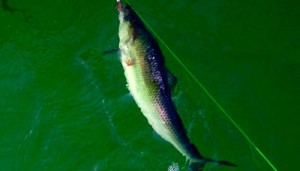 White shad are an anadromous species that spend the vast majority of their life at sea, but enter the Chesapeake region in the spring to spawn. They are highly sought-after for both their flesh and their roe. It is delicious. White shad are also an important species in American history. The Native Americans fished for them extensively and used the left-overs to fertilize their crops. George Washington was known as a prolific white shad angler and caught thousands near his home on the Potomac River. It was the spring shad run in Pennsylvania’s Schuylkill River that saved Washington’s army from starvation at Valley Forge. Read More!
White shad are an anadromous species that spend the vast majority of their life at sea, but enter the Chesapeake region in the spring to spawn. They are highly sought-after for both their flesh and their roe. It is delicious. White shad are also an important species in American history. The Native Americans fished for them extensively and used the left-overs to fertilize their crops. George Washington was known as a prolific white shad angler and caught thousands near his home on the Potomac River. It was the spring shad run in Pennsylvania’s Schuylkill River that saved Washington’s army from starvation at Valley Forge. Read More!


